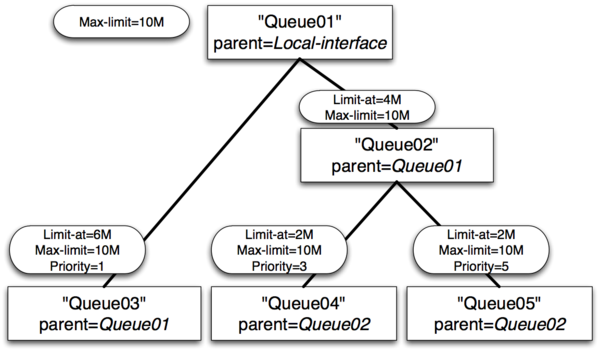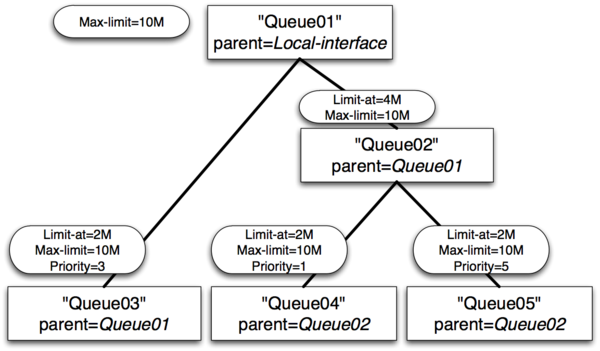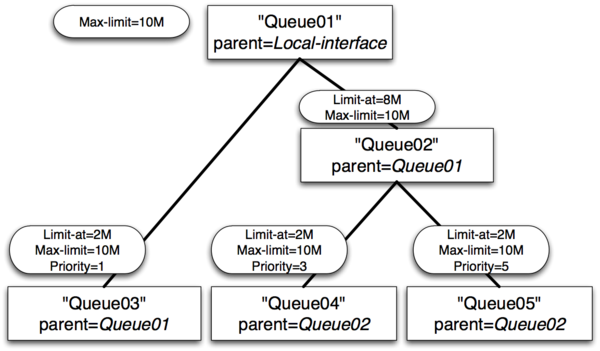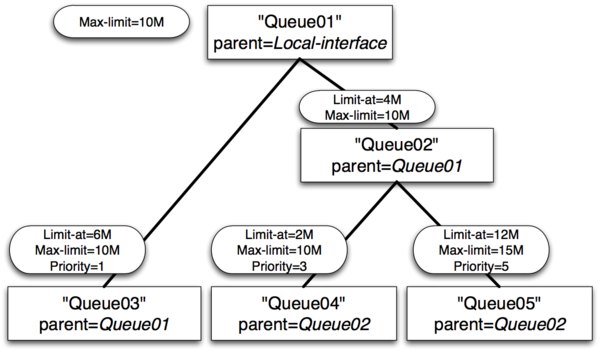Manual:HTB: Difference between revisions
No edit summary |
|||
| Line 15: | Line 15: | ||
* '''MIR''' (Maximal Information Rate) – ('''max-limit''' in RouterOS) best case scenario, rate that flow can get up to, if there queue's parent has spare bandwidth | * '''MIR''' (Maximal Information Rate) – ('''max-limit''' in RouterOS) best case scenario, rate that flow can get up to, if there queue's parent has spare bandwidth | ||
In | In other words, at first '''limit-at''' ('''CIR''') of the all queues will be satisfied, only then child queues will try to borrow the necessary data rate from their parents in | ||
order to reach their '''max-limit''' ('''MIR'''). | order to reach their '''max-limit''' ('''MIR'''). | ||
Revision as of 09:02, 13 November 2009
Theory
Structure
Hierarchical Token Bucket (HTB) allows to create a hierarchical queue structure and determine relations between queues, like "parent-child" or "child-child".
As soon as queue has at least one child it becomes a inner queue, all queues without children - leaf queues. Leaf queues make actual traffic consumption, Inner queues are responsible only for traffic distribution. All leaf queues are treated on equal basis.
In RouterOS it is necessary to specify parent option to assign queue as a child to other queue
Dual Limitation
Each queue in HTB has two rate limits:
- CIR (Committed Information Rate) – (limit-at in RouterOS) worst case scenario, flow will get this amount of traffic no matter what (assuming we can actually send so much data)
- MIR (Maximal Information Rate) – (max-limit in RouterOS) best case scenario, rate that flow can get up to, if there queue's parent has spare bandwidth
In other words, at first limit-at (CIR) of the all queues will be satisfied, only then child queues will try to borrow the necessary data rate from their parents in order to reach their max-limit (MIR).
Note: CIR will be assigned to the corresponding queue no matter what. (even if max-limit of the parent is exceeded)
That is why, to ensure optimal (as designed) usage of dual limitation feature, we suggest to stick to these rules:
- Sum of committed rates of all children must be less or equal to amount of traffic that is available to parent.
- CIR(parent)* ≥ CIR(child1) +...+ CIR(childN)
- *in case if parent is main parent CIR(parent)=MIR(parent)
- CIR(parent)* ≥ CIR(child1) +...+ CIR(childN)
- Maximal rate of any child must be less or equal to maximal rate of the parent
- MIR (parent) ≥ MIR(child1) & MIR (parent) ≥ MIR(child2) & ... & MIR (parent) ≥ MIR(childN)
Queue colors in Winbox:
- 0% - 50% available traffic used - green
- 51% - 75% available traffic used - yellow
- 76% - 100% available traffic used - red
Priority
We already know that limit-at (CIR) to all queues will be given out no matter what.
Priority is responsible for distribution of remaining parent queues traffic to child queues so that they are able to reach max-limit
Queue with higher priority will reach its max-limit before the queue with lower priority. 8 is the lowest priority, 1 is the highest.
Make a note that priority only works:
- for leaf queues - priority in inner queue have no meaning.
- if max-limit is specified (not 0)
Examples
In this section we will analyze HTB in action. To do that we will take one HTB structure and will try to cover all the possible situations and features, by changing the amount of incoming traffic that HTB have to recycle. and changing some options.
Structure
Our HTB structure will consist of 5 queues:
- Queue01 inner queue with two children - Queue02 and Queue03
- Queue02 inner queue with two children - Queue04 and Queue05
- Queue03 leaf queue
- Queue04 leaf queue
- Queue05 leaf queue
Queue03, Queue04 and Queue05 are clients who require 10Mbps all the time Outgoing interface is able to handle 10Mbps of traffic.
Example 1 : Usual case
- Queue01 limit-at=0Mbps max-limit=10Mbps
- Queue02 limit-at=4Mbps max-limit=10Mbps
- Queue03 limit-at=6Mbps max-limit=10Mbps priority=1
- Queue04 limit-at=2Mbps max-limit=10Mbps priority=3
- Queue05 limit-at=2Mbps max-limit=10Mbps priority=5
Result of Example 1
- Queue03 will receive 6Mbps
- Queue04 will receive 2Mbps
- Queue05 will receive 2Mbps
- Clarification: HTB was build in a way, that, by satisfying all limit-ats, main queue no longer have throughput to distribute
Example 2 : Usual case with max-limit
- Queue01 limit-at=0Mbps max-limit=10Mbps
- Queue02 limit-at=4Mbps max-limit=10Mbps
- Queue03 limit-at=2Mbps max-limit=10Mbps priority=3
- Queue04 limit-at=2Mbps max-limit=10Mbps priority=1
- Queue05 limit-at=2Mbps max-limit=10Mbps priority=5
Result of Example 2
- Queue03 will receive 2Mbps
- Queue04 will receive 6Mbps
- Queue05 will receive 2Mbps
- Clarification: After satisfying all limit-ats HTB will give throughput to queue with highest priority.
Example 3 : Inner queue limit-at
- Queue01 limit-at=0Mbps max-limit=10Mbps
- Queue02 limit-at=8Mbps max-limit=10Mbps
- Queue03 limit-at=2Mbps max-limit=10Mbps priority=1
- Queue04 limit-at=2Mbps max-limit=10Mbps priority=3
- Queue05 limit-at=2Mbps max-limit=10Mbps priority=5
Result of Example 3
- Queue03 will receive 2Mbps
- Queue04 will receive 6Mbps
- Queue05 will receive 2Mbps
- Clarification: After satisfying all limit-ats HTB will give throughput to queue with highest priority. But in this case inner queue Queue02 had limit-at specified, by doing so, it reserved 8Mbps of throughput for queues Queue04 and Queue05. From these two Queue04 have highest priority, that is why it gets additional throughput.
Example 4 : Leaf queue limit-at
- Queue01 limit-at=0Mbps max-limit=10Mbps
- Queue02 limit-at=4Mbps max-limit=10Mbps
- Queue03 limit-at=6Mbps max-limit=10Mbps priority=1
- Queue04 limit-at=2Mbps max-limit=10Mbps priority=3
- Queue05 limit-at=12Mbps max-limit=15Mbps priority=5
Result of Example 4
- Queue03 will receive ~3Mbps
- Queue04 will receive ~1Mbps
- Queue05 will receive ~6Mbps
- Clarification: Only by satisfying all limit-ats HTB was forced to allocate 20Mbps - 6Mbps to Queue03, 2Mbps to Queue04, 12Mbps to Queue05, but our output interface is able to handle 10Mbps. As output interface queue is usually FIFO throughput allocation will keep ratio 6:2:12 or 3:1:6




